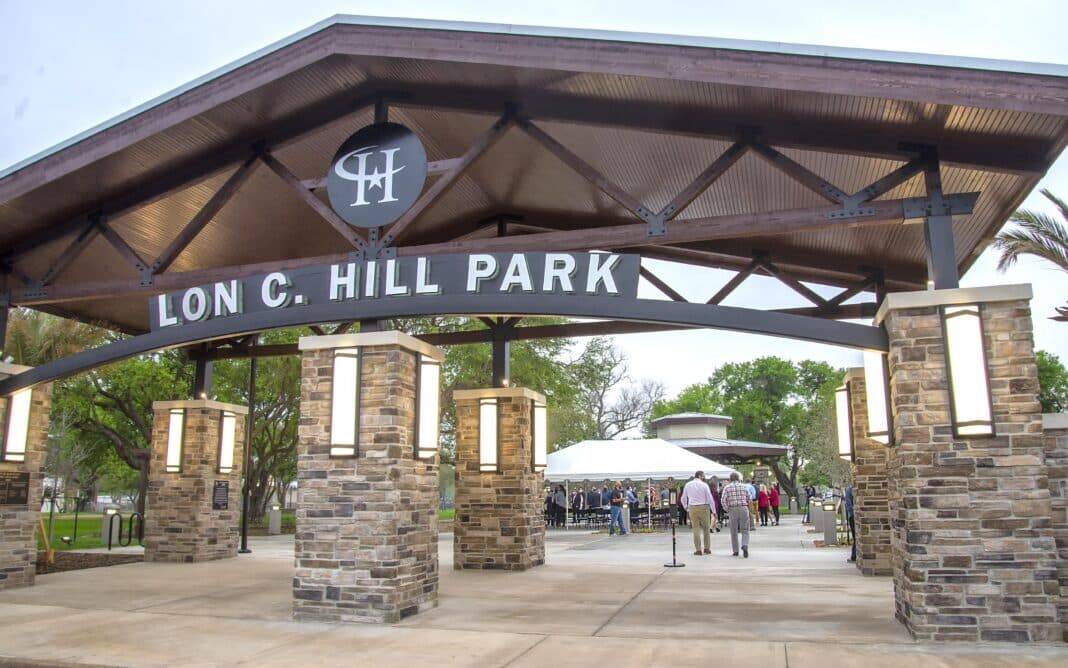|
Only have a minute? Listen instead
Getting your Trinity Audio player ready...
|
HARLINGEN — The supply chain crisis is leading officials to slam the brakes on some of the city’s biggest projects following years of planning.
The latest project placed on hold is the second phase of the multi-million-dollar plan to turn Lon C. Hill Park into a regional destination draw.
Meanwhile, soaring costs are squeezing the Harlingen Community Development Board’s budget, funded through an eighth-cent sales tax earmarked to finance so-called quality-of-life projects.
For the third time in about two years, city commissioners returned to the board last week, requesting an additional $400,000 for the $5.5 million project aimed at transforming the Tony Butler Golf Course into a money-maker, weeks after board members granted their request for an extra $2 million.
PARK PROJECT COST NEARLY DOUBLES
Last week, city commissioners meeting with members of the Harlingen Community Improvement Board agreed to “pause” the project’s second phase after the coronavirus pandemic’s supply chain crisis’ materials cost escalations pushed the price tag of a proposed adaptive sports park from an estimated $916,062 to $1.7 million.
“If we fund this deficit, that would wipe out this board until the next fiscal year,” City Manager Gabriel Gonzalez told board members during a May 2 meeting, referring to the agency’s fund balance.
Last month, officials announced plans to also hold off on the second phase’s $2.5 million amphitheater after designs showed the project would eat into the proposed destination park’s limited parking, Javier Mendez, the city’s parks director, has said.
ADAPTIVE FIELD ‘PAUSED’
Under the city’s past administration, the second phase marked some of the proposed destination park’s most ambitious projects.
With the proposed amphitheater planned to seat audiences as big as 792, with 524 more on a grassy hill, the project included a 225-foot adaptive field and a $727,950, nearly 1-mile-long lighted trail.
As part of the project to build the adaptive field, officials planned synthetic turf for the ball park designed to create a playing field for special needs children.
But funding the project would have squeezed the improvement board’s budget, draining a $1.7 million unassigned fund balance.
“That’s a lot of money,” board Chairman Paul Durant told officials, referring to the adaptive park’s climbing costs while questioning the project.
“I’ve struggled over the past two years understanding the demand for it,” he said.
‘INCLUSIVITY’ THEME
During a presentation, Mendez said the proposed adaptive field complemented the park’s award-winning all-inclusive playground, now a fixture at other city parks.
Designed to make the park a destination for all families — and all children, the adaptive field was planned as a venue for the Miracle League, sponsoring teams made up of children with special needs, while the park could also stage Little League games, offering the nearby Boys and Girls Club a playing field.
“The destination park — our original idea was to promote all-inclusive facilities or components for the public,” Mendez told officials. “That’s our whole idea — to increase inclusivity in that park for the general public and for the surrounding community.”
GOLF COURSE PROJECT CLOSTS CLIMB
But faced with funding the Tony Butler Golf Course’s additional costs, board members voted 4-3 to “pause” the proposed destination park’s second phase.
Under the city’s past commission, the improvement board had originally set aside $3.1 million to fund the project.
Then in January, amid the supply chain’s cost escalations, Mid America Golf and Landscape, a Lee’s Summit, Mo., company, proposed a $4.7 million construction bid.
By the time officials requested the improvement board squeeze out an additional $2 million last month, Mid America’s bid had expired, leading the company to tack about $400,000 to the price tag.
“I know how this must look to the board,” Gonzalez told board members during the meeting. “We just got $2 million from this body just a few weeks ago, but there was a change in the pricing structure.”
SQUEEZING FUND BALANCE
During discussion, board member John Guevara expressed concern the golf course’s expenses were draining the agency’s budget.
“Every dollar that we put into the golf course, we have less money to put into something that might pop up,” he told board members. “I’m concerned about some of the other projects that we have.”
Amid debate, Durant called on board members to fund the added expense.
“You know, this is a project that’s been ongoing and to stop now would not be appropriate as hard as it is to take an extra $400,000,” he said. “I would recommend to the board that it be approved because stopping a project over $400,000 at this point, it would push everybody back — the time frames, everything else that we need to get up to par so it could start generating income on its own and be self-sufficient. I would encourage the board to consider the difficulty of swallowing this and do it. The alternative, I don’t think, would be good.”
CALL FOR ‘ACCOUNTABILITY’
After more than five years on the drawing board, officials are planning to transform the iconic 94-year-old golf course, replacing the 18-hole course’s 40-year-old network of leaking PVC pipe while renovating its greens as part of a plan to draw more players to drive the course out of its 10-year hole.
“That’s a lot of money to be given to just one project,” Mayor Norma Sepluveda told officials. “However, I think in the future it’ll be better for it and it will be successful.”
Sepulveda warned many residents stand against funding the project.
“When I talk to constituents, they’re either 100 percent for it or 100 percent against it,” she said.
Meanwhile, Sepulveda called on officials to update board members on the project set to launch on Sept. 25, when they plan to shut down the 18-hole course until construction’s completed in April, a period during which they project to lose about $700,000.
“I think there has to be accountability and communication and transparency along the way,” she said.




